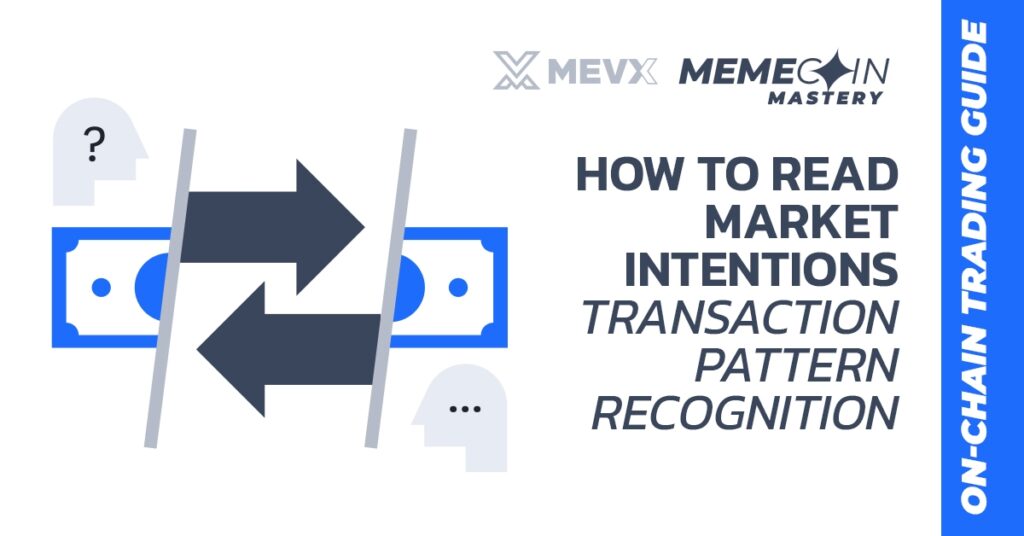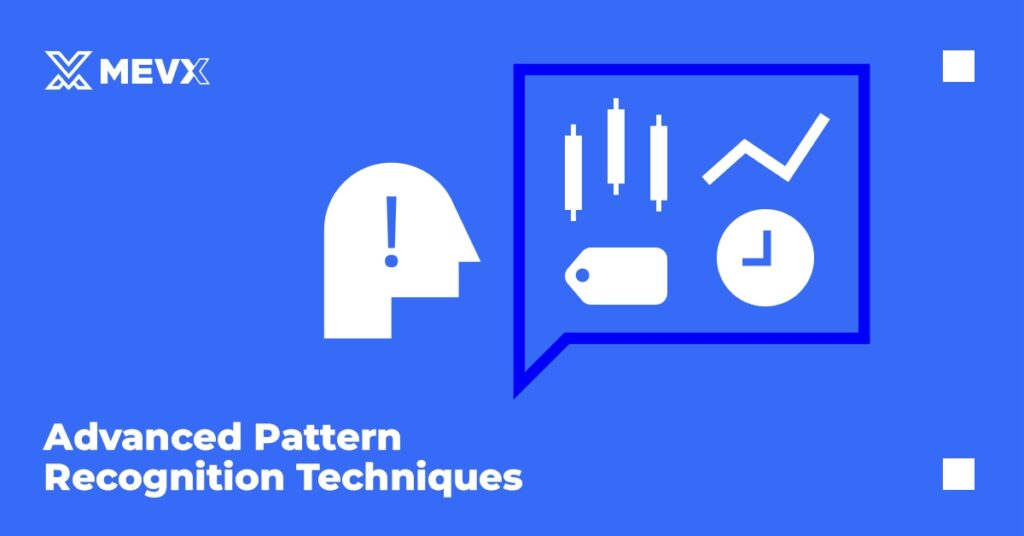In meme coin trading, price action is only half the story. The real edge lies beneath the surface, in the transaction patterns. By learning how to read market intentions and interpret wallet behavior, trading volume, and token movement across timeframes, you can detect whale strategies, spot fake volume, and anticipate market moves before they hit the charts.
This article dives deep into how to build your pattern recognition toolkit.

How to Read Market Intentions
To learn how to read market intentions, first you need to understand transaction patterns.
Understanding Transaction Patterns
Transaction patterns reveal the underlying market structure and participant behavior. On-chain trading analysis exposes the mechanics driving price movements.
This transparency allows you to identify whale accumulation, bot activity, and genuine community engagement before these patterns become visible in price action.
Analyzing Buy/Sell Patterns Onchain
Trading volume is distributed across different transaction sizes. Healthy organic growth typically shows:
- Diverse Transaction Sizes: A mix of small retail trades, medium-sized transactions, and occasional large purchases.
- Gradual Volume Increases: Organic interest builds over time, creating steady volume growth patterns rather than sudden spikes followed by immediate drops.
- Buy/Sell Ratio Evolution: Monitor how the ratio of buying to selling pressure changes throughout different price phases. Sustainable rallies show consistent buying pressure across multiple price levels.
Transaction Timing Patterns
- Clustering Analysis: Look for unusual clustering of transactions within short timeframes.
- Response Time Monitoring: Measure how quickly the market reacts to significant transactions. Immediate responses often indicate bot activity or coordinated trading groups.
- Cross-Time Zone Activity: Analyze trading patterns across different global time zones. Projects with genuine international interest show distributed activity, while artificially pumped tokens often concentrate activity in specific regions.
Bot Detection and MEV Activity Identification
Bots leave distinct fingerprints in transaction data:
- Uniform Transaction Amounts: Repeated transactions of identical or mathematically related sizes often indicate automated systems.
- Precise Timing Intervals: Transactions occurring at exact time intervals (every 30 seconds, every 2 minutes) suggest programmatic execution.
- Gas Price Optimization Patterns: Sophisticated bots use consistent gas optimization strategies that create recognizable patterns in transaction costs.
MEV (Maximum Extractable Value) Recognition
MEV activity significantly impacts meme coin trading outcomes. Key indicators include:
- Sandwich Attack Patterns: Large transactions preceded and followed by smaller opposite-direction trades from the same wallet within seconds.
- Front-Running Signatures: Transactions that consistently appear immediately before significant market moves, often with higher gas fees to ensure priority execution.
- Arbitrage Loops: Rapid sequences of trades across multiple DEXs to exploit price differences, often completing within the same block.
Whale Movement Tracking and Alerts
Identifying Whale Wallets
- Established Whales: Wallets with consistently large holdings and trading history across multiple tokens.
- New Large Holders: Recently funded wallets making significant purchases, which may indicate insider activity or institutional interest.
- Temporary Large Positions: Wallets that quickly accumulate and distribute large amounts, often associated with MEV or arbitrage activities.

Whale Behavior Analysis
- Accumulation Patterns: Track how whales build positions over time.
- Distribution Strategies: Monitor whale selling patterns. Systematic distribution across multiple transactions and price levels suggests planned exits, while panic selling creates different on-chain signatures
- Cross-Token Behavior: Analyze whale activity across their entire portfolio.
Setting Up Effective Whale Alerts
To stay ahead of whale moves, build a monitoring system that tracks:
- Transactions above a specific dollar value or token %
- New wallets making large buys
- Wallet composition changes
- Whale activity cross-referenced with social sentiment
Platforms like Solscan, Birdeye, and DeBank can be configured with watchlists and alerts.
Volume Authenticity – Spotting Real vs. Fake Activity
Not all volume is organic. Distinguish between hype and real traction with these techniques:
Transaction Distribution
- Organic trading has a wide range of transaction sizes.
- Artificial volume often clusters around specific ranges (e.g., many small trades to simulate activity).
Wallet Age & History
- New wallets suddenly contributing a large volume = red flag.
- Check if wallets have prior history with other tokens or sudden large inflows.
Timing Patterns
- Real projects show global interest: 24-hour volume curves.
- Fake activity is often regionally timed.
Detecting Wash Trading and Manipulation
Wash trading is a tactic to fake liquidity and hype. Learn to catch it early:
- Circular Token Movement: Tokens are moving between a few wallets with no net ownership change.
- Profit/Loss Irregularity: Repeated trades that incur fees but yield no clear profit goal.
- Volume vs. Holder Ratio: Excessive volume with very few active wallets = likely artificial.
Example: A token with $2M volume but only 300 holders is a warning sign.
Advanced Pattern Recognition Techniques
Developing intuition requires multi-layered analysis across timeframes.

Multi-Timeframe Observation
- Minute-level: High bot or MEV activity
- Hourly: Regional buying cycles
- Daily/Weekly: Long-term trends, whale moves, project cycles
Correlation Mapping
- Price vs. Volume: Lagging volume often signals trend exhaustion
- Social vs. Onchain: Match meme virality with token movement
- Cross-token: Compare patterns across similar meme coins
How to Apply Pattern Recognition in Trading
Once you detect meaningful patterns, translate them into actionable strategy.
Pre-Entry Checklist
- Whale accumulation in progress?
- Distribution trend started?
- Bot activity high or low?
- Volume growing organically?
Position Management
- Enter during the accumulation phases
- Size positions based on bot and liquidity conditions
- Plan exists near the top of the distribution arcs
- Risk Control: Use alerts for MEV surges or large wallet exits
- Stay adaptive: patterns evolve fast in meme markets
Real-Time Monitoring for Smart Decisions
To execute effectively, set up systems that provide:
- Live alerts for suspicious wallet movement
- Whale tracker dashboards
- Volume anomaly indicators
- Verified on-chain news channels
Combining tools like Birdeye, DexScreener, SolanaFM, and MevX analytics allows you to react before retail does.
Building Your Pattern Recognition Edge
Like any skill, mastery comes from repetition. Here’s how to sharpen your edge:
- Choose 2–3 meme coins to follow closely
- Log transaction patterns daily for each
- Build a “pattern library” of signals that worked (and failed)
- Study the timing and context of each whale move, pump, or dump
Over time, you’ll start seeing the market like a language. Transaction patterns reveal the psychology of price movement. Once you train your eye, you’ll anticipate market shifts while others just react.
Quick Checklist – Transaction Pattern Intelligence Kit
Before entering any meme coin:
- Whale accumulation confirmed?
- Volume appears organic and distributed?
- No signs of wash trading?
- Holder count match the volume?
- No bot-dominated price action?
- Live alerts and watchlists set up?
Conclusion: Trade with Insight, Not Emotion
Markets reward clarity and preparation. By mastering transaction pattern analysis, you unlock an edge that hype traders never see.
When others are chasing green candles, you’ll already know the move was coming, because the wallets told you. Stay observant, data-driven, and focused, and meme coin trading becomes a game of informed timing, not luck.
In the next article, we’ll explore contract functions, how to decode smart contract code, and protect yourself from malicious mechanics.
Share on Social Media:
